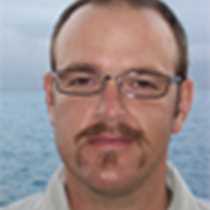Santa Cruz Island
Dark clouds obscured our next destination as we approached the island early in the morning. Many small vessels bobbing up and down in the bay indicated a busy destination as we anchored at Academy Bay by Santa Cruz Island. The human population has grown quite quickly over the past 15 years, and we find ourselves among approximately 15,000 people who call this home. Our interaction with this human settlement allows us a view into the delicate balance between humans and the Galápagos National Park and a peek into the conservation efforts made here.
Continuing into the Charles Darwin Research Station we come upon the tortoise program that is managed by the Galápagos National Park Service (GNPS). Recently hatched tortoises are observed as we find that a simple program of protection was all that is needed to bring a species back from almost extinction. Tortoises will be cared for until they are sufficiently large enough to be released back onto their island of origin, this occurs as the GNPS works on elimination of invasive species that may harm them. Breeding in captivity also occurs here, and we find that the Española population that numbers over 2,000 individuals on the island originates from a base group of only 12 females and three males. It is incredible that such delicate numbers can save a population that was decimated by us humans for centuries. From the rustic research station we make our way into Puerto Ayora, the bustling hub of the human species here in the archipelago, and we have a chance to witness human behavior in its “natural” environment.
Our journey continues as we head to the highlands of Santa Cruz, and almost immediately we note a difference in temperature from the hot coastal area to a cooler atmosphere. Santa Cruz has various settlements in the highlands, and we stop at Bella Vista to observe what is grown and produced by one of the local families. Sugar cane is used here for many products in Ecuador including cane juice, molasses, raw sugar, and cane spirit, and we are able to try all of its versions while watching juice being extracted with a cane press. Café, bananas, and plantains are abundant as we talk to the local family and get a glimpse into island life.
Arriving almost to the top of Santa Cruz Island we visit another local family that owns a productive farm and has an incredible view of various islands from their restaurant. Before lunch we explore a lava tube that shows us the underground plumbing of the volcanic past here in Galápagos and conveniently leads us to our meal. Lunch is plentiful as we prepare ourselves for an afternoon search for the Santa Cruz population of giant tortoises. Various farms in the highlands happen to be directly in the migratory path of the tortoises, however this is not an impediment to their ancient call to feed and reproduce. Tortoises during this season are hard to find as the males and females head towards the lowlands for reproduction, yet we are able to find a couple larger males among the grasslands. Getting low to the ground in front of a tortoise we are able to look into the eyes of the history of Galápagos.
Uniqueness abounds as we continue to a large cloud forest of sunflower trees (Genus Scalesia ) close to the top of Santa Cruz. This journey takes longer than expected as our local endemic bus decides to stop working for a short period of time, nevertheless this allows us a chance to witness the vermillion flycatcher in all its crimson glory. Large pit craters are found in the center of the forest and we all are surprised at the difference of flora found only at this altitude here in Galápagos. Upon our return to our home, the National Geographic Islander, and our departure away from the lights of “civilization,” we are content to have met the “locals” with their distinct view of life.




